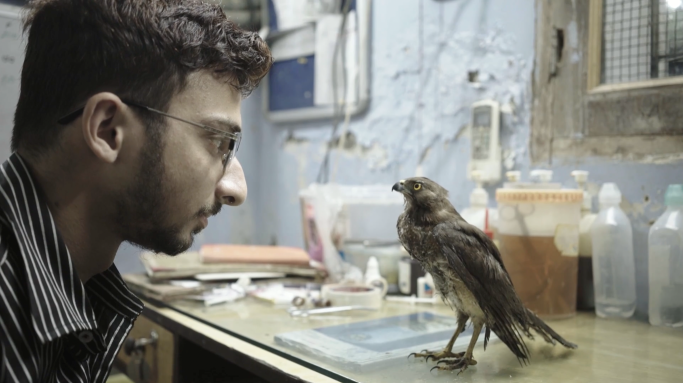The nature documentary All That Breathes presents plenty of wildlife, but you won’t hear David Attenborough’s narration. There are no high-flying cinematographers shooting grand vistas from helicopters, and you can forget National Geographic–style close-ups of cute, colorful creatures.
Nonetheless, Shaunak Sen’s Hindi-language film finds beauty within the debris of New Delhi, in the midst of garbage strewn streets, squeaking rats, and noisy hogs, as two brothers, Nadeem and Saud, rescue injured black kites. The hawk-like raptors swarm the skies scavenging for food, and are increasingly overcome by the city’s pollution. The murkiness of toxic air around one of the world’s most populated cities creates dim conditions that lead the birds to collide with buildings, power lines, and even paper kite strings.
Keen cinematography elevates the dismal surroundings to a visual pleasure with beautifully composed frames by director of photography Benjamin Bernhard: a blurry cityscape reflected in a puddle sharpens into focus, flashlights illuminate faces during a blackout, and a flock of kites flap like butterflies against a smoggy sky. Crisp sound recordings of animal noises and background music, along with the gentle chimes in the score by Roger Goula, add to the lyrical soundtrack.
Muslims in a largely Hindu nation, the brothers have heard that feeding kites raw meat will earn them religious credit (sawab), and the birds “will eat away your difficulties,” as Nadeem puts it in his poetic voice-over, where he describes a kite as “a furious reptile from another planet.” There is a sense that as minorities in India, they can relate to the bedraggled birds. Rising religious tension and persecution has their community under siege, with severe discrimination and violent attacks. “Violence is communication,” says Nadeem.
In a ramshackle basement where the brothers run a soap dispenser business, their side hustle as ersatz veterinarians continues day by day in the makeshift clinic. They are obsessive in their work, which gives them purpose. It takes precedence over family life for Saud, who is married with a child, but he tends to the raptors at all hours. Wearing rubber gloves and delicately handling a sick creature, he can diagnose metabolic bone disease or tenderly wrap an injured bird in white gauze.
The endeavor includes a young volunteer, Salik, who hauls boxes of kites into the basement. Nadeem handles the administrative side of the business and applies for animal rescue funding, while eyeing educational opportunities in the United States. (In 2020, the New York Times ran a feature on their kite rehabilitation operation. The publicity led to financing for a bona fide wildlife hospital, the brothers’ dream.) Their philosophy stretches beyond nursing injured and ailing birds and encompasses a respect for all living things, “all that breathes,” in the urban ecosystem that includes goats, lizards, monkeys, and mosquitoes. “Life itself is kinship. We’re all a community of air,” are spoken words that define their ecological outlook.
As scavengers, the kites are a benefit to society, picking through and thus reducing massive landfills. But could the migratory birds of prey be vectors for disease, to either other animals or humans? The film dodges this question.
New Delhi–based director Sen focuses on the fringes of society. His first feature documentary, Cities of Sleep (2016), looked at sheltering environments for the local homeless population. Absolute in its humanitarian aim, and almost hypnotic in its meditative qualities, it’s no wonder his All That Breathes won top honors in the documentary competitions at Cannes and Sundance this year, before screening in the main slate of the New York Film Festival earlier this month.
All That Breathes will open at select theaters on October 21, ahead of its debut on HBO in 2023.







Leave A Comment